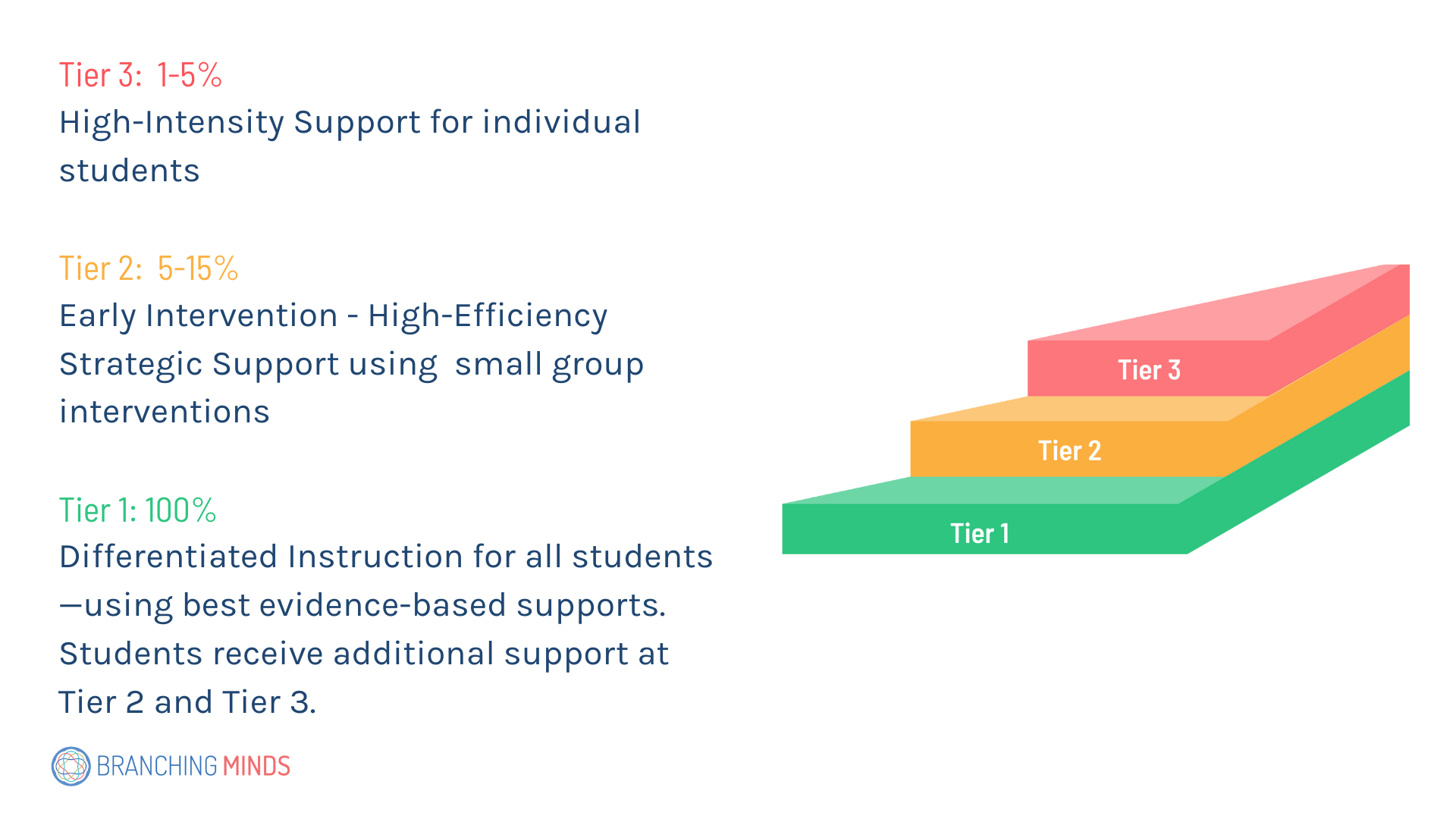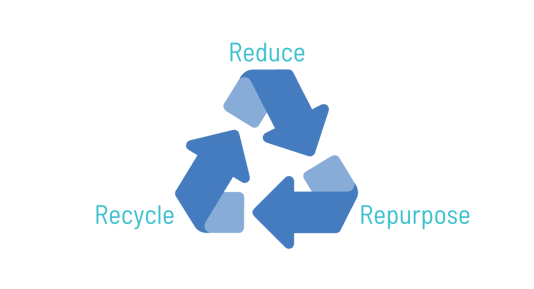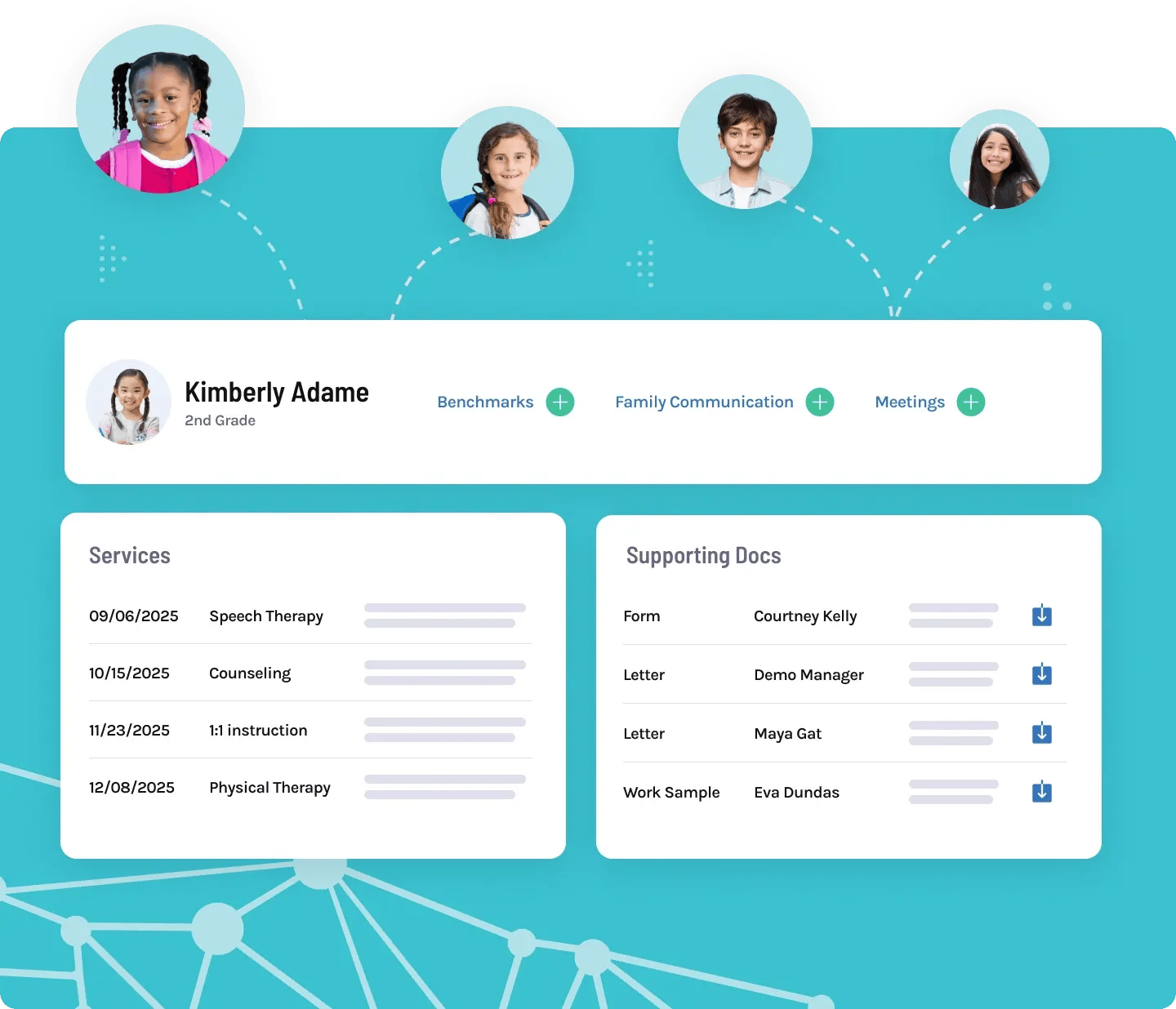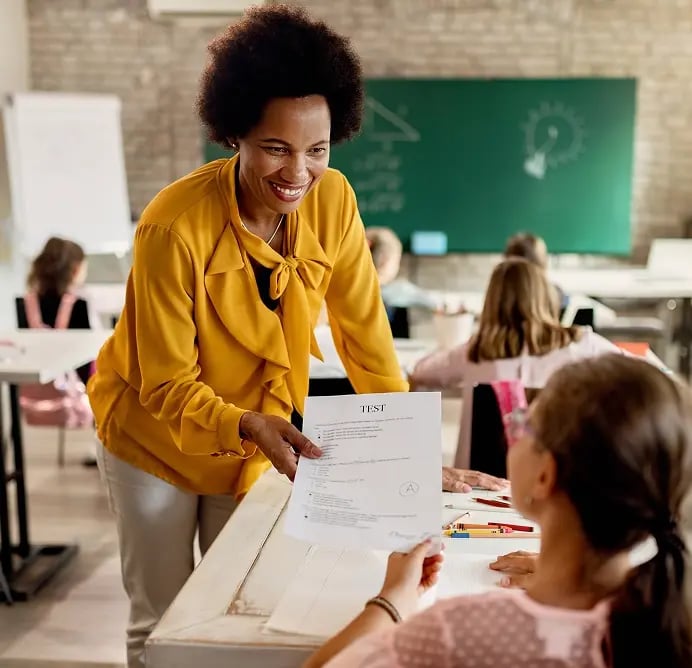About two years ago, I was a district administrator for school climate improvement. In this role, I was asked to support a group of administrators that were handling intense behaviors on their campus. The campus had maxed out its intensive support resources, and determined that they had no other option than to create a new tier of support—what they referred to as “Tier 4.”
Key Tier 2 Instruction and interventions Takeaways
- Tier 2 builds on Tier 1: Effective Tier 2 support is layered onto strong, differentiated Tier 1 instruction and guided by screening data to identify students in need.
- Targeted and timely: Interventions are delivered in small groups, made accessible as soon as students show signs of struggle, and include explicit, interactive instruction.
- Driven by data: Ongoing progress monitoring is essential to evaluate student response and adjust support accordingly.
I have noticed this trend quite often. I hear different variations of this new level of need: “Tier 4,” “deep red,” or even “too many red students.”What does this mean?
A Multi-Tiered System of Supports is based on the three-tiered public health model. This means that we must identify the root cause(s) within our current system and identify why it’s not serving our student population. By creating an additional tier, we ignore a problem that is perforating our entire system.
There is no Tier 4. However, there is a Tier 2. And this tier is often overlooked in how powerful of an intervention tool it can be.
The Challenge With Tier 2 Implementation
As an education leader, I found it easy to speak about improving Tier 1 instruction. I would plan professional development, provide opportunities for instructional rounds, and use data to make sure we had a healthy core (meaning that at least 80% of our students were meeting benchmarks with Tier 1 instruction alone).
I also found that my MTSS teams were extreme advocates for student support. They could create an individualized, intensive Tier 3 plan for a student. We allocated individual staff and connected resources at this level with ease. But where does this leave Tier 2? What I find are two scenarios.
The first scenario is a misunderstanding between Tier 1 support and Tier 2 intervention. The second scenario is directly related to confusion between Tier 1 and Tier 2, leaving schools to allocate too many resources to provide an over-abundance of students with intensive, individualized instruction—having nowhere else to turn. Unfortunately, because Tier 2 is so hard to define in practice, it sometimes becomes ineffective or even nonexistent.
Fortunately, I know that educators try to do what is best for their students when given the proper information and tools. I believe that a lack of appropriate Tier 2 support exists because of two important truths.
- Tier 2 is hard to define.
- Tier 2 is challenging to implement within our current constraints.
My goal is to share how you can build a foundation for Tier 2 instruction and support, create structures that allow the opportunity for Tier 2 instruction and support to exist, and make Tier 2 fit within your school, district, and state constraints.
Moreover, we’ll take a peek at best practices for grouping, providing Tier 2 instruction and intervention for reading, math, and social-emotional learning.
What Are the Tiers in a Multi-Tiered System of Supports?
Before we dig into Tier 2, let’s make sure we understand what each of the tiers within a multi-tiered framework means.
A Multi-Tiered System of Supports (MTSS) is a whole-school, prevention-based framework that relies on data-based problem-solving to support all students within a layered continuum of evidence-based practices and systems. MTSS, as a foundation, provides academic, behavioral, and social-emotional interventions organized into three tiers of support.
The three tiers are also known as levels of support or instruction and intervention that educators provide to students. There are various resources, strategies, and tools within each level that support our students’ various needs.
- Tier 1: whole class data-driven differentiated core instruction provided to 100% of our students
- Tier 2: whole-class differentiated instruction + small group targeted instruction (in addition to core instruction) provided to roughly 15% of our students
- Tier 3: whole class core differentiated instruction + additional targeted instruction (often small group in addition to core instruction) + intensive support provided to less than 5% of our students

The Differentiation Deal
Because Tier 1 instruction provides the foundation for Tier 2 instruction and intervention, it can sometimes be tricky to identify when you have moved from instruction to intervention. The following chart is a quick check reference for determining if you’re differentiating or providing Tier 2 instruction and intervention.
|
Tier 1 Instruction |
Tier 2 Instruction and Intervention |
|
|
A Basic Foundation for Tier 2 Instruction and Intervention
Tier 2 instruction and interventions are seamlessly layered onto Tier 1 Differentiated Core Instruction.
Tier 2 instruction and interventions build upon a strong Tier 1 instruction foundation. A strong Tier 1 foundation means that about 15% of our total population may need additional support to meet grade-level standards.
Like Tier 1 Instruction, Tier 2 instruction and interventions should be high-quality and evidence or research-based. Tier 2 instruction and interventions are supplemental to the core instruction, meaning that as identified students begin to receive Tier 2 instruction and interventions, they continue accessing their high-quality, Tier 1 instruction. When we consider the MTSS pyramid, we look at it as layers upon layers—instead of isolated places of support.
Tier 2 instruction and interventions rely on an analysis of screening data to identify at-risk students and determine the health of the Tier 1 Differentiated Core.
Another foundational component of Tier 2 instruction and intervention is the use of universal screening data. Universal screening data can serve two essential purposes:
- Identify the effectiveness of Tier 1 instruction.
- Identify students who need additional support.
That second purpose is the foundation of our discussion. Through a thorough analysis of student data, collaboration teams can group students with similar needs or skill deficits. Through this process, interventions can occur in group support plans—providing more targeted instruction and intervention.
Important note: If you notice that more than 15% of your population demonstrates a need for Tier 2 targeted instruction and intervention, your team of professionals should examine your Tier 1 instructional practice, materials, and environments to ensure it is differentiated to meet current student needs.
➡️ Related Resource: A Quick Review of MTSS Supports, Interventions, and Accommodations
Best Practices for Tier 2 Instruction and Intervention
While Tier 2 begins with a strong Tier 1 foundation, additional best practices for Tier 2 instruction and intervention are needed.
Tier 2 instruction and interventions provide targeted support for small groups of students who are unsuccessful with Tier 1 instruction alone.
A key difference between Tier 1 instruction and Tier 2 intervention is the focus on targeted skills.
Tier 1 instruction is standards-driven, focusing on students' broad skills and generalizing to a learning target.
In contrast, Tier 2 interventions target a specific skill deficit that has been identified through assessment. Instruction and intervention targets this specific skill, and educators monitor growth on that specific skill with a normed progress monitoring tool.
In a group setting, a team can look at the group as a whole to determine students with similar skill needs to create intervention groups. It is important to remember that progress monitoring tools are essential components of these plans. These tools ensure that students respond to group intervention plans and provide insight into further action.
Tier 2 instruction and interventions should be readily accessible to support students as they demonstrate need.
Most research indicates that once a student demonstrates a need for targeted instruction or intervention, they should have access to it within 72 hours.
This means that our Tier 2 supports should be pre-designed, scheduled, and require low effort for teachers or interventionists to support. Here are some steps to make this actionable within a school setting:
- Across campus, plan to implement three to four academic and three to four SEL/behavioral Tier 2 interventions with strong evidence that are readily accessible.
- Allocate resources (like time, staff, and materials) to targeted interventions at the beginning of the year so there are no surprises.
- Ensure that teams know how and when to access or apply targeted supports.
- Skip adding interventions, programs, or tools mid-year unless there is a data-driven need. Teams can become confused and unsure of what to do next. If Tier 2 is too challenging to access, teachers may skip that step altogether.
By following these steps, teams will not have to spend hours thinking about what Tier 2 intervention will work best, and they will not have to navigate how to implement it. This streamlined process aids in creating an environment where Tier 2 is a viable option.
Tier 2 instruction and interventions include systematic and explicit instruction and interaction between the educator and the student.
Tier 2 instruction and intervention should be closely linked to Tier 1 instruction, though there are some important differences. Explicit instruction is a way of teaching where the teacher provides overt instruction on the skill and allows the student to practice with scaffolds until they achieve mastery systematically.
We support the learner by giving clear directions and expectations, using clear and direct language and vocabulary, and monitoring the student's progress, positively providing immediate, specific corrective feedback.
Luckily, many databases, such as What Works Clearinghouse, curate interventions. These databases take the guesswork out of identifying quality interventions by evaluating the trustworthiness and validity of the research behind the interventions. The higher the evidence rating, the more likely the intervention includes systematic, explicit instruction with continuous opportunities for positive corrective feedback.
In addition to these best practices in explicit instruction, students receiving behavioral interventions benefit from pre-corrections; or providing reminders before the student engages in non-preferred tasks to support their application of the preferred response.
➡️ To learn more about supporting students in need of tier 2 support, check out this on-demand webinar
Tier 2 instruction and interventions must be frequently progress monitored through the use of progress monitoring tools.
Students identified as needing interventions should be provided with frequent opportunities to demonstrate progress toward acquiring a particular skill.
Progress monitoring tools provide insight into how well an intervention is supporting a student’s growth toward their skill-based goal. Progress monitoring assessments and tools are:
- Quick
- Skill-based
- Valid
- Reliable assessments
- Sensitive to small changes in short amounts of time
These assessments/tools are also often normed, demonstrating how same-age peers perform consistently over time. They are given to students receiving intervention support and are administered at a consistent cadence based on need and as written in the student’s plan.
Progress Monitoring Assessments and Curriculum-Embedded Assessments
Before we go any further, I want to clarify a common misconception. Progress monitoring assessments are not to be confused with curriculum embedded assessments.
We use summative and formative assessments ongoing throughout our instruction to gather data on student performance related to a particular learning outcome. These assessments are known as curriculum-embedded assessments. Curriculum-embedded assessments may be a part of your intervention tool or program. Don’t confuse these embedded assessments with progress monitoring assessments.
Progress monitoring assessments measure specific skill growth. These tools effectively help us determine if the intervention we have selected is appropriately aligned to the student’s skill deficit and if a plan is working. It helps teams have the data to decide on continuing or discontinuing interventions.
➡️ Check out this MTSS Intervention Process Flowchart
Structuring Your MTSS To Support Tier 2 With Fidelity
Tier 2 is challenging and a common trend is skipping it altogether. So how can you ensure your Tier 2 instruction and intervention is available to all staff and any student that needs it?
To ensure we create a system that includes strong Tier 2 instruction and intervention support, we must think about how the resources and people will flow around the building to ensure these interventions are easily and quickly accessible.
Complete a Resource Audit
Resource auditing (or mapping) is not a new technique. Resource mapping helps us align our resources with student needs more efficiently. It’s also a clear visual representation of how your MTSS supports learners at various levels.
Round up your resources and lay them out (yep, all of them!) Take time to identify what needs the resource meets and when it should be used. For example, check out the table below for a sample of this resourcing:
|
Resource |
Grade-level |
Subject |
Level of Support |
|
Wilson Fundations |
K-3 |
Reading |
Tier 2 |
Good news: you can use the Branching Minds Resource Audit Worksheet to help your team!
Determine Your Wants and Needs for Your Student Population
Write down your wants for your students and your school. Think about your vision and your beliefs.
Then, work with a team of stakeholders and analyze your data to determine your needs. Consider the following in this list:
- Demographics
- Population
- Geographic location
- Access to resources outside of school
- Early warning system
- Screening data
- Progress monitoring assessment data
- Any other pertinent data
Rather than think about individual or small group student needs, think about your data from a larger perspective; that of your allocation of resources, time, and staff.
Reduce, Repurpose, Recycle Your Resources
Once you have completed your audit and determined your wants and needs, you can begin to reduce, repurpose, and recycle (toss!) resources to better align them based on your current constraints and your student and teacher strengths.
- Reduce: narrow and streamline your resources. More does not always mean better! Identify the instructional resources that best match your campus and eliminate the rest. Focus on implementing a few interventions at Tier 2 WELL!
- Repurpose: I have worked on many master schedules and position control. Para-professionals and classroom aides are often scheduled along with the same guidelines as a teacher from bell to bell. Be creative. Repurpose staff to provide intervention minutes during transitions and other moments on campus.
- Recycle: Is your master schedule stuck in the 90s with RTI? Do you plan for Tier 2 intervention when you design your master schedule, or do you plan for it the first day the need arises? The most dangerous statement I hear is, “that’s the way we’ve always done it!” It’s okay to toss programs, resources, schedules, and data sources that aren’t serving you or your students.

Once you create an appropriate schedule and align staff, time, and instructional resources, planning to implement Tier 2 interventions with fidelity will be a breeze. All that’s left is progress monitoring to ensure your interventions meet your student’s needs.
Designing Your MTSS Practice With Tier 2 Data in Mind
Data routines help us identify how well our interventions are working and to what extent we are implementing our plans with fidelity. By answering a few simple questions at our grade level PLC meetings or our school-wide meetings, we can identify if our Tier 2 targeted interventions support identified students in meeting their goals with independence.
- Have we identified who needs additional targeted skill support?
- Have we grouped students by similar skills or functions?
- Are we implementing the plan as it was designed?
- What are the progress monitoring data saying about the intervention and skill gap?
As educators, we engage in data routines ongoing throughout the year. But what do we do at the close of the year? Beyond ensuring that students continue to have access to appropriate support over the summer, what can we do with the end-of-year data, especially when considering Tier 2?
- Plan for a comprehensive articulation of the student’s Tier 2 plans to the next grade level.
- Regroup with your MTSS School-Level team and review universal screening data to see how students moved along the tier levels. As students receive Tier 2 interventions, their needs should decrease. Check to see how many of your students that received Tier 2 interventions saw a positive change in their screening scores.
- Identify trends from particular interventions that worked for your campus’ needs. Perhaps a particular intervention or staff member had more impact than others. Find out why! And extend that work within your master MTSS plan for the following year!
Tried and True Tier 2: Experience From the Field
On a personal note, I have to say Tier 2 has always been my sweet spot. I love to get to know students on a deeper level, and instructing small groups since I have left my classroom has always been an outlet for me.
As I support schools in their MTSS implementation, I love watching teachers and teams smile when they begin to see the bigger picture for Tier 2 through a systems vantage point instead of siloed in their classroom.
The place between Differentiated Tier 1 and Intensive Tier 3 can be a turning point for so many of our students when implemented with fidelity. It’s never too late or too early to start planning a systems-level review of your Tier 2 practices.
|
Additional resources you may find helpful: ➡️ Best Practices for Meetings and How to Apply Them to MTSS |
![[Guest Author] Brittany Shurley-avatar](https://www.branchingminds.com/hs-fs/hubfs/image0.jpeg?width=82&height=82&name=image0.jpeg)
About the author
[Guest Author] Brittany Shurley
Brittany Shurley has served students, educators, and leaders in various roles throughout her career including as a classroom teacher, learning disabilities specialist, school-based leader, and district level administrator. Brittany has extensive experience in facilitating the implementation of an MTSS at the district and school levels. She is passionate about ensuring teachers have the tools to promote safe, healthy, and engaging learning environments where students are experiencing success.

MTSS Shouldn't Be So Hard
Empower your team with actionable insights that drive success for your students, staff, and school(s).
















.png?width=716&height=522&name=MTSS-interventions-secondary-school(preview).png)
